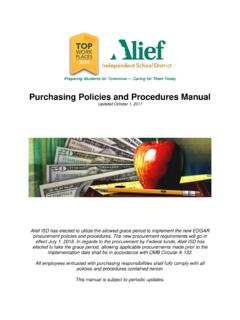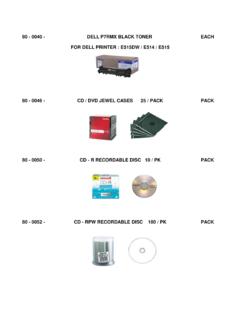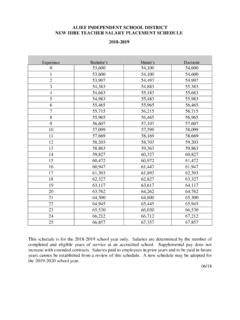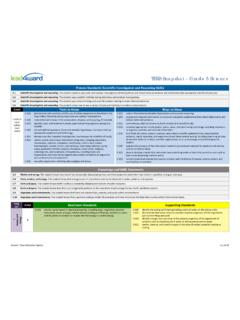Transcription of TEKS Snapshot – Grade 7 Science
1 teks Snapshot Grade 7 Science ^ = Student Expectation specifically included in STAARTM Assessed Curriculum at Grade 8 (classified as a Readiness or Supporting Standard in Grade 7 based on its characteristics as part of the Grade 7 Science curriculum) * = Aligned with STAARTM Assessed Curriculum at Grade 8 Source: Texas Education Agency Process Standards (Scientific Investigation and Reasoning Skills) Scientific investigation and reasoning. The student, for at least 40% of the instructional time, conducts laboratory and field investigations following safety procedures and environmentally appropriate and ethical practices.
2 Scientific investigation and reasoning. The student uses scientific inquiry methods during laboratory and field investigations. Scientific investigation and reasoning. The student uses critical thinking, scientific reasoning, and problem solving to make informed decisions and knows the contributions of relevant scientists. Science investigation and reasoning. The student knows how to use a variety of tools and safety equipment to conduct Science inquiry. Tools to Know Ways to Show (A) demonstrate safe practices during laboratory and field investigations as outlined in the Texas Safety Standards (B) practice appropriate use and conservation of resources, including disposal, reuse, or recycling of materials (A) plan and implement comparative and descriptive investigations by making observations, asking well-defined questions, and using appropriate equipment and technology (B) design and implement experimental investigations by making observations, asking well-defined questions, formulating testable hypotheses, and using appropriate equipment and technology (A)
3 Use appropriate tools to collect, record, and analyze information, including life Science models, hand lens, stereoscopes, microscopes, beakers, Petri dishes, microscope slides, graduated cylinders, test tubes, meter sticks, metric rulers, metric tape measures, timing devices, hot plates, balances, thermometers, calculators, water test kits, computers, temperature and pH probes, collecting nets, insect traps, globes, digital cameras, journals/notebooks and other equipment as needed to teach the curriculum (B) use preventative safety equipment, including chemical splash goggles, aprons, and gloves and be prepared to use emergency safety equipment, including an eye/face wash, a fire blanket, and a fire extinguisher (C) collect and record data using the International System of Units (SI) and qualitative means such as labeled drawings, writing, and graphic organizers (D) construct tables and graphs, using repeated trials and means, to organize data and identify patterns (E) analyze data to formulate reasonable explanations, communicate valid conclusions supported by the data, and predict trends (A)
4 In all fields of Science , analyze, evaluate, and critique scientific explanations by using empirical evidence, logical reasoning, and experimental and observational testing, including examining all sides of scientific evidence of those scientific explanations, so as to encourage critical thinking by the student (B) use models to represent aspects of the natural world such as human body systems and plant and animal cells (C) identify advantages and limitations of models such as size, scale, and properties, and materials (D) relate the impact of research on scientific thought and society, including the history of Science and contributions of scientists as related to the content Knowledge and Skills Statements Matter and energy.
5 The student knows that interactions occur between matter and energy. Matter and energy. The student knows that matter has physical and chemical properties and can undergo physical and chemical changes. Force, motion, and energy. The student knows that there is a relationship among force, motion, and energy. Earth and space. The student knows that natural events and human activity can impact Earth systems. Earth and space. The student knows components of our solar system. Organisms and environments. The student knows that there is a relationship between organisms and the environment. Organisms and environments.
6 The student knows that populations and species demonstrate variation and inherit many of their unique traits through gradual processes over many generations. Organisms and environments. The student knows that living systems at all levels of organization demonstrate the complementary nature of structure and function. Organisms and environments. The student knows that a living organism must be able to maintain balance in stable internal conditions in response to external and internal stimuli. Organisms and environments. The student knows that reproduction is a characteristic of living organisms and that the instructions for traits are governed in the genetic material.
7 teks Snapshot Grade 7 Science ^ = Student Expectation specifically included in STAARTM Assessed Curriculum at Grade 8 (classified as a Readiness or Supporting Standard in Grade 7 based on its characteristics as part of the Grade 7 Science curriculum) * = Aligned with STAARTM Assessed Curriculum at Grade 8 Source: Texas Education Agency Rptg Cat Readiness Standards Supporting Standards 1 Matter and Energy (A) recognize that radiant energy from the Sun is transformed into chemical energy through the process of photosynthesis (C)^ diagram the flow of energy through living systems, including food chains, food webs, and energy pyramids (B) demonstrate and explain the cycling of matter within living systems such as in the decay of biomass in a compost bin (A)^ identify that organic compounds contain carbon and other elements such as hydrogen, oxygen, phosphorus, nitrogen, or sulfur (B)
8 ^ distinguish between physical and chemical changes in matter in the digestive system (C) recognize how large molecules are broken down into smaller molecules such as carbohydrates can be broken down into sugars 2 Force, Motion, and Energy (A)^ contrast situations where work is done with different amounts of force to situations where no work is done such as moving a box with a ramp and without a ramp, or standing still (B) illustrate the transformation of energy within an organism such as the transfer from chemical energy to heat and thermal energy in digestion (C) demonstrate and illustrate forces that affect motion in everyday life such as emergence of seedlings, turgor pressure, and geotropism 3 Earth and Space (A) predict and describe how different types of catastrophic events impact ecosystems such as floods, hurricanes, or tornadoes (A) analyze the characteristics of objects in our solar system that allow life to exist such as the proximity of the Sun, presence of water, and composition of the atmosphere (B) analyze the effects of weathering, erosion, and deposition on the environment in ecoregions of Texas (C)
9 ^ model the effects of human activity on groundwater and surface water in a watershed (B) identify the accommodations, considering the characteristics of our solar system, that enabled manned space exploration 4 Organisms and Environments (A)* observe and describe how different environments, including microhabitats in schoolyards and biomes, support different varieties of organisms (B) explain variation within a population or species by comparing external features, behaviors, or physiology of organisms that enhance their survival such as migration, hibernation, or storage of food in a bulb (A) investigate and explain how internal structures of organisms have adaptations that allow specific functions such as gills in fish, hollow bones in birds, or xylem in plants (D)^ differentiate between structure and function in plant and animal cell organelles, including cell membrane, cell wall, nucleus, cytoplasm, mitochondrion, chloroplast, and vacuole (B)^ compare the results of uniform or diverse offspring from sexual reproduction or asexual reproduction (B)^ describe how biodiversity contributes to the sustainability of an ecosystem (C)
10 ^ observe, record, and describe the role of ecological succession such as in a microhabitat of a garden with weeds (A)^ examine organisms or their structures such as insects or leaves and use dichotomous keys for identification (C)^ identify some changes in genetic traits that have occurred over several generations through natural selection and selective breeding such as the Galapagos Medium Ground Finch (Geospiza fortis) or domestic animals (B)^ identify the main functions of the systems of the human organism, including the circulatory, respiratory, skeletal, muscular, digestive, excretory, reproductive, integumentary, nervous, and endocrine systems (C) recognize levels of organization in plants and animals, including cells, tissues, organs, organ systems, and organisms (E) compare the functions of a cell to the functions of organisms such as waste removal (F)^ recognize that according to cell theory all organisms are composed of cells and cells carry on similar functions such as extracting energy from food to sustain life (A)







